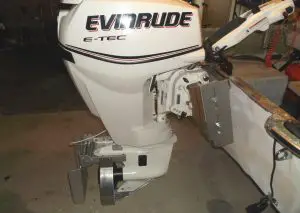Shaft length will be shorter for twins for V hulls
I copied this from an article.
Shaft Length by Type of Boat
Picking the right shaft length is mostly a factor of the transom height or the back of the boat. But in many cases, it’s a little more complicated than that alone. Boat hulls are designed in three basic types that range from slow displacement and semi-displacement hulls to the fastest planing hulls.
If you are running a slower boat, the exact location of the ventilation plate is less important. Having the cavitation plate a bit lower than the transom is preferable to having it too high. This will keep the prop in the water when the boat pitches in waves, or hobby-horses. Workboats, sailboats, and displacement-hulled boats fall into this category. On this type of boat, if you are in doubt, default to the longer-shafted outboard.
The faster your boat, the more critical it is to get the sizing just right. If your boat planes, pay extra attention to getting the shaft length as close to perfect as possible. An inch or two probably won’t make a big difference, but any more than that will lead to trouble. Problems with getting the ventilation plate too low include slower hole-shot and lower top-end speeds. Bass boats,
ski boats, or center cockpit vessels will want to double-check their measurements to get it just right. The performance of these boats depends on quite a lot of factors, but getting the outboard length just right is an essential first step.
Jack Plates and Transom Brackets
Many boat transoms are modified to use a different length of outboard by using a bracket. Offshore vessels are often equipped with a large mounting bracket so that the transom can be left at full height. This provides seaworthiness and offers maximum protection from large seas. These allow the mounting of a standard length outboard behind the transom.
Smaller boats may use adjustable jack plates that can be changed to fit any outboard. Sailboats use these sometimes, as well as some boaters who want to install a much smaller auxiliary motor to use in case of primary engine failure. Brackets are also handy for boats that do not have flat transoms, like canoe-stern sailboats or fan-tailed motor vessels.
Beefier jack plates can be fitted should a boater be looking to mount an outboard with a shorter shaft than their transom demands. They’re also useful if the back of your boat has a non-standard measurement. With a jack plate, you can mount it exactly where you want it.
How to Measure Transom Height
For vessels with transom-mounted outboards, you can easily figure out which type of outboard you need to get. Measure from the top of the transom to the bottom of the hull. Your goal is to measure how the outboard will sit, so start from the clamping plate and follow the centerline of the hull. Measure straight down to the lowest point on the hull. For vee-shaped hulls, the lowest spot of the hull will come to point, while on flat-bottomed boats it will be more or less level. The lowest point will likely be directly under your drain plug if you’ve got one.
If you are running a twin-engine setup, then measure the same distance from each clamping plate to the bottom of the hull. This number will likely be shorter than that for a single-engine installation since you do not necessarily measure to the point of the keel.
For boats equipped with a bracket, calculate the same measurement but based on the bracket and not the transom. Wherever the outboard clamping bracket is, use this as the basis for measurement.
If your boat is newer and the manufacturer is still in business, you might also want to try to give them a call. Chances are the boat was designed with a specific size of outboard in mind. If you are looking to repower, they may be able to offer some sage advice. Check the literature about your model boat online, and you may be surprised to find that the number is published for you. It’s still smart to measure it yourself though, just in case, the design changed over the years. With such an important, long-term, and expensive upgrade, it’s never a bad idea to double-check.
How to Measure an Outboard
If you’re going the other way around and trying to figure out how long the shaft on your outboard is, measuring it is equally easy. This is handy if you’re shopping for second-hand outboards or looking to sell the one that came with your boat.
Use the mounting bracket on the motor to know where it will sit on the boat. The flat part of the bracket that rests on the transom when mounted will give you the same point of reference as the transom does on the boat. Measure from there down to the top of the cavitation plate, also known as the anti-ventilation plate. The cavitation plate is the horizontal surface of the lower unit immediately above the propeller.



